HISTORICAL CHANGE OF BUCA GEOGRAPHY
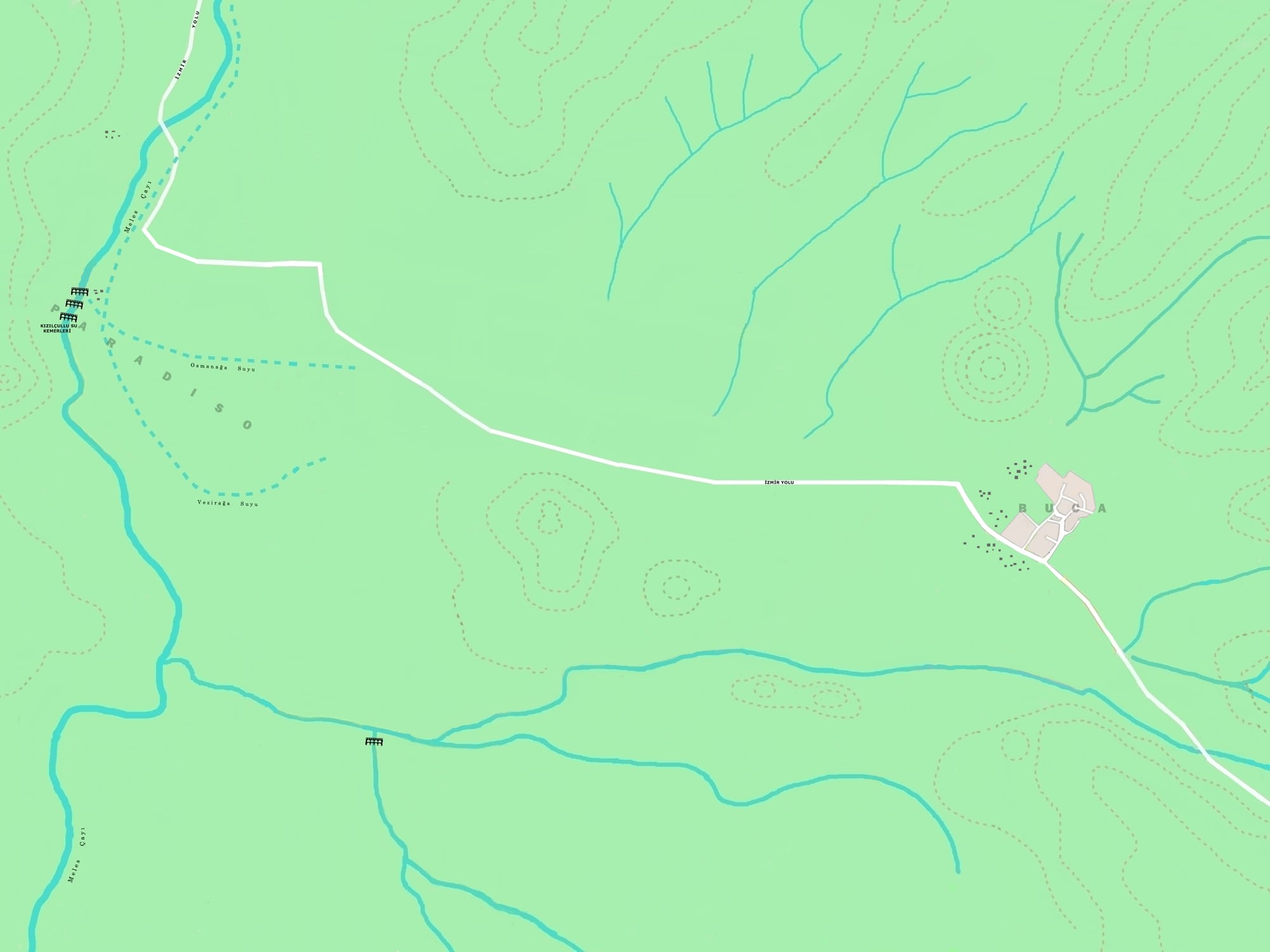
HISTORICAL CHANGE OF BUCA GEOGRAPHY
- Preface -
In this study, it is aimed to portray the historical change of the region, which we can define as Buca Plain (Greek: Kambos), from Kozağaç to Tıngırtepe and from Tınaztepe to Kızılçullu aqueducts, with the help of maps. Rather than discussing the regions on the maps in detail; It was aimed to emphasize the geographical change of the region by highlighting the changes of rivers, residential areas, roads and some known lands.
Although efforts have been made to minimize the margin of error by examining the sources related to Buca, it is of course possible that there will be minor errors on the maps resulting from lack of information. It should not be forgotten that as we go further back in time, it becomes more difficult to predict exactly where Buca's settlement borders fall. For this reason, some borders have been tried to be drawn as accurately as possible within the framework of the information obtained from the sources.
- 1600s -
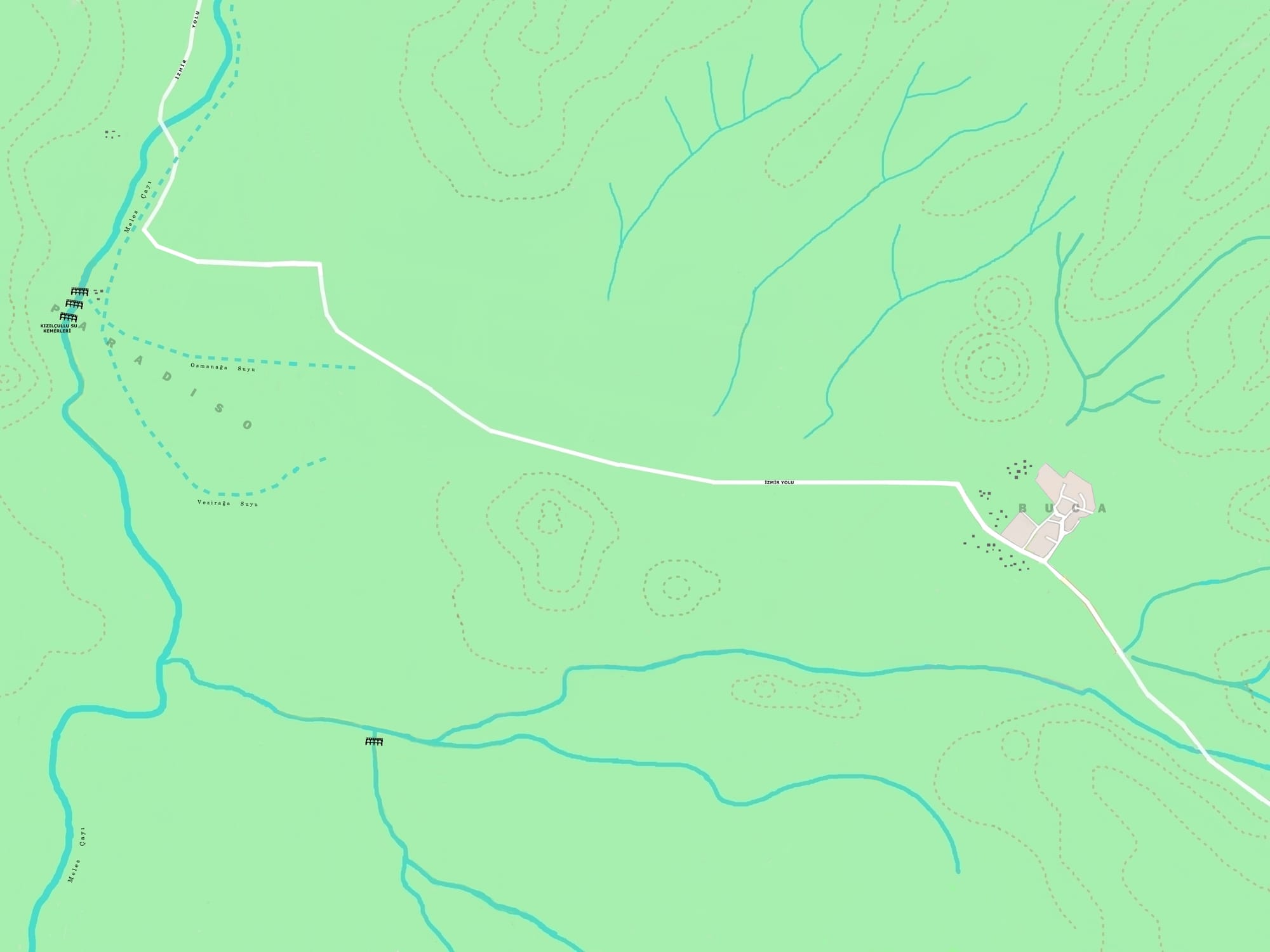 1600'lü yıllarda Buca Ovası - Tam ekran için tıklayınız.Buca entered the history scene in the 1600s. There is no evidence that there was a regular settlement in Buca before the 17th century. Hilda Voltera Barff, in her article in the magazine "the Candlesticks" published by the Izmir Anglican Church, stated that Buca was described as "a place consisting of trees and streams" in a Dutch book. Famous traveler Evliya Çelebi, who lived in the 17th century, also talked about Buca as follows: "I arrived at this village, it was like a place of heaven on earth." We ate its long yellowish seedless grapes, drank from its cold springs, and met pleasure-loving friends from Izmir. They would collapse on a beautiful bench.'' As can be understood from here, at that time, Buca was a region with abundant water resources, generously fed by the water coming from the surrounding hills.
1600'lü yıllarda Buca Ovası - Tam ekran için tıklayınız.Buca entered the history scene in the 1600s. There is no evidence that there was a regular settlement in Buca before the 17th century. Hilda Voltera Barff, in her article in the magazine "the Candlesticks" published by the Izmir Anglican Church, stated that Buca was described as "a place consisting of trees and streams" in a Dutch book. Famous traveler Evliya Çelebi, who lived in the 17th century, also talked about Buca as follows: "I arrived at this village, it was like a place of heaven on earth." We ate its long yellowish seedless grapes, drank from its cold springs, and met pleasure-loving friends from Izmir. They would collapse on a beautiful bench.'' As can be understood from here, at that time, Buca was a region with abundant water resources, generously fed by the water coming from the surrounding hills.
The population of Buca consists of Greeks. It is obvious that the founders of Buca were Greeks. Buca is also mentioned as a Christian village in the diplomatic documents of the French Consulate in Izmir dated 1688. It seems unlikely that European families would be in Buca during this period. Buca was probably a small village with a population of 1,000-2,000, consisting entirely of Greeks during this period.
There was probably no regular settlement in the area known as Şirinyer today and called Paradiso at that time. The Buca Plain was largely untouched at that time and most of the land belonged to the state.
- 1700s -
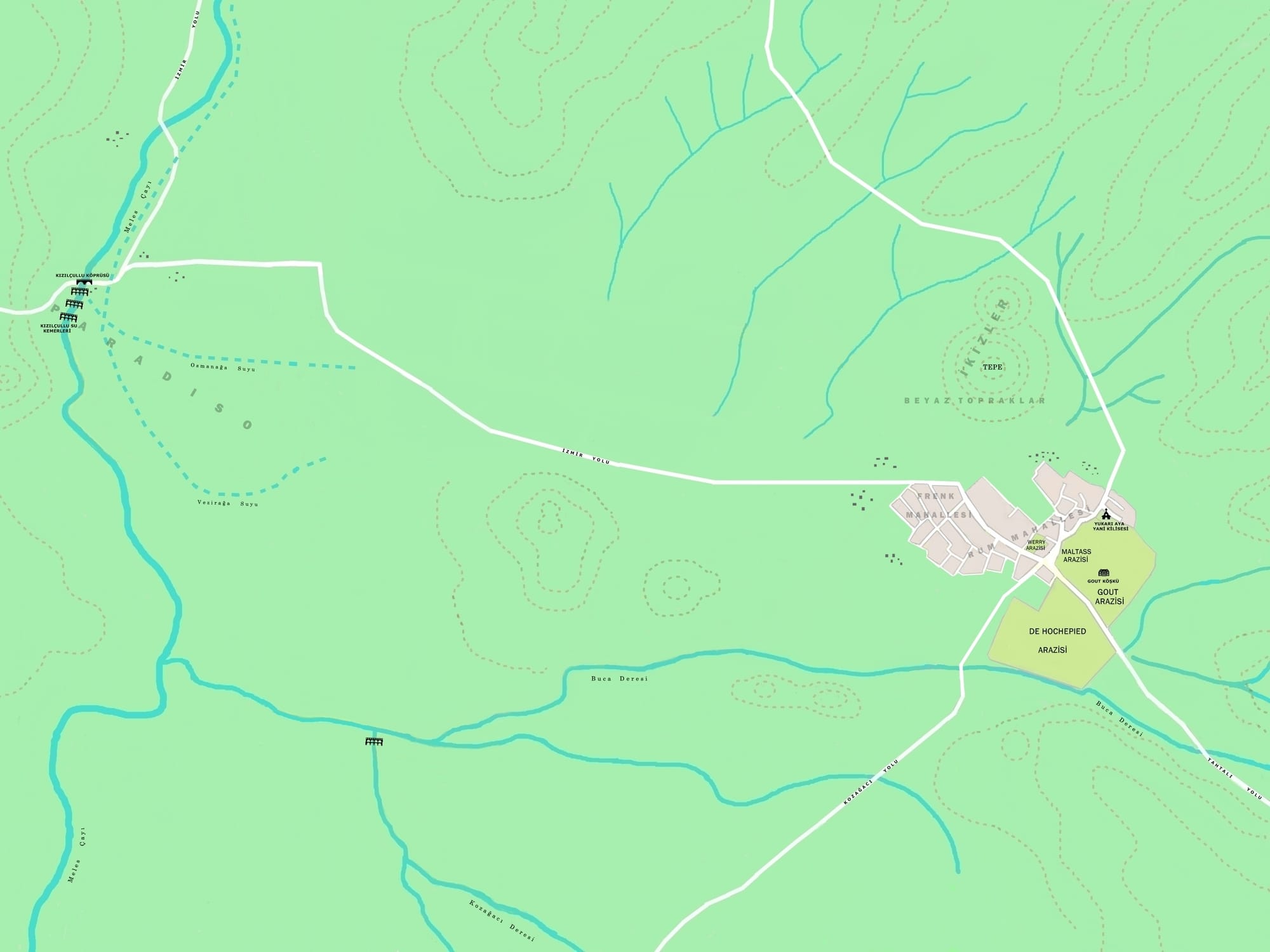 1700'lü yıllarda Buca Ovası - Tam ekran için tıklayınız.It is obvious that Buca started to develop since the 18th century. Buca village began to be preferred as a summer resort by European families. During this period, it is seen that the Greek population continued to come to Buca, especially to the Peloponnese. During this period, the Greek neighborhood in Buca began to expand. According to Kararas, Buca's neighborhoods began to take shape in this period. European families started to buy large properties in Buca. It is known that the De Hochepied, Maltass, Gout and Werry families owned large estates in Buca during this period, and these families were probably accompanied by many other families at that time. According to Teodoris Kontaras, British families started to live in Buca from the end of the 18th century.
1700'lü yıllarda Buca Ovası - Tam ekran için tıklayınız.It is obvious that Buca started to develop since the 18th century. Buca village began to be preferred as a summer resort by European families. During this period, it is seen that the Greek population continued to come to Buca, especially to the Peloponnese. During this period, the Greek neighborhood in Buca began to expand. According to Kararas, Buca's neighborhoods began to take shape in this period. European families started to buy large properties in Buca. It is known that the De Hochepied, Maltass, Gout and Werry families owned large estates in Buca during this period, and these families were probably accompanied by many other families at that time. According to Teodoris Kontaras, British families started to live in Buca from the end of the 18th century.
Water mills can be found in Paradiso during this period. This increases the possibility of regular settlement in this region. However, no evidence in this direction has been found. In addition, Buca Plain is still largely untouched.
- Between 1800 and 1850 -
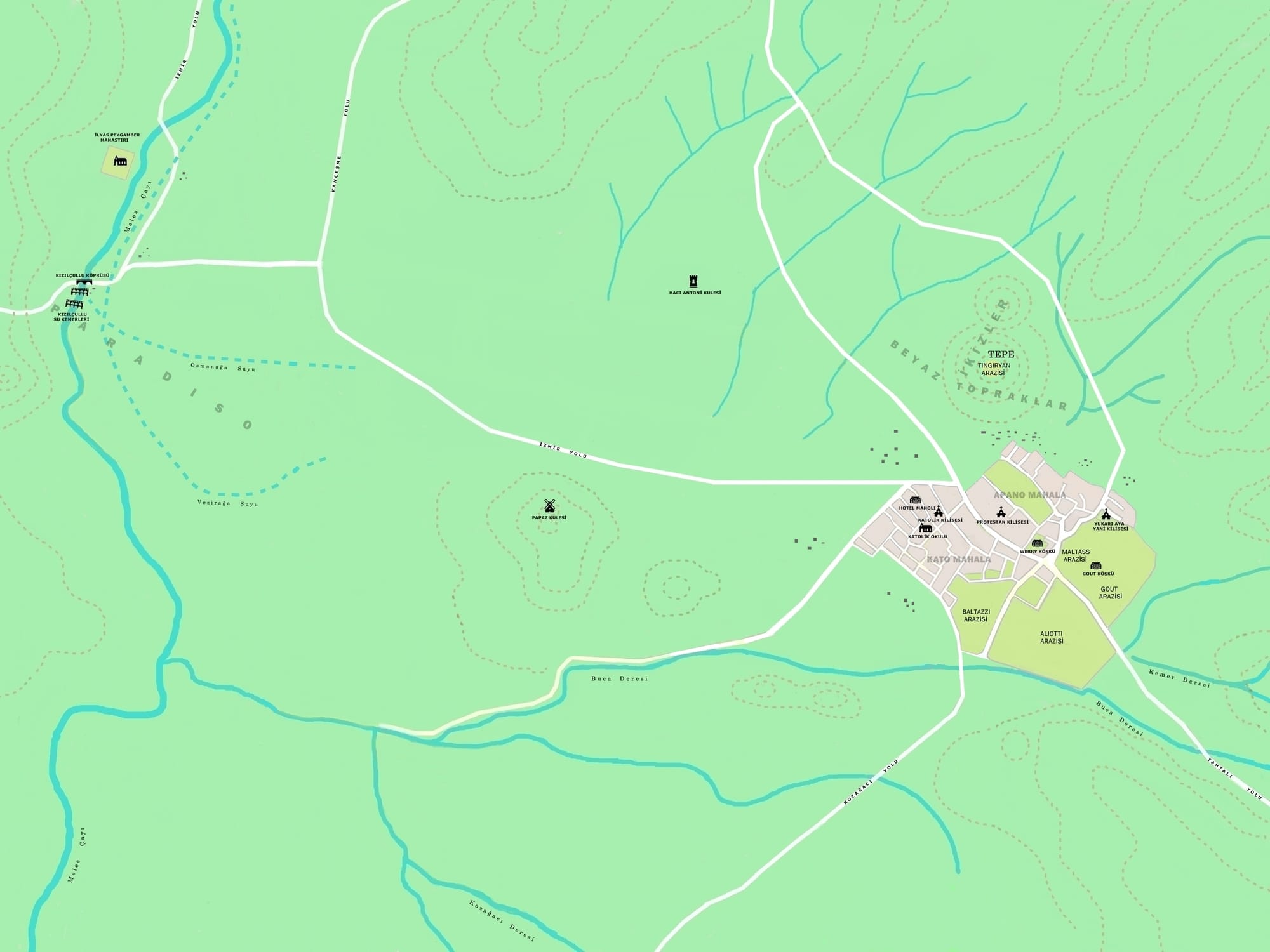 1800 - 1850 arasında Buca Ovası - Tam ekran için tıklayınız.Buca's population growth accelerated during this period. Many European families settled in Buca. Some of them bought houses in Buca for summer vacation purposes, although not permanently. The arrival of famous Buca families such as Baltazzi, De Jongh and Rees also coincides with this period. According to Kararas, 500 Catholics lived in Buca during this period. With the addition of Protestants to this number, it can be said that the Western population alone easily exceeds 1,000 people. The Greek population continued to come to Buca.
1800 - 1850 arasında Buca Ovası - Tam ekran için tıklayınız.Buca's population growth accelerated during this period. Many European families settled in Buca. Some of them bought houses in Buca for summer vacation purposes, although not permanently. The arrival of famous Buca families such as Baltazzi, De Jongh and Rees also coincides with this period. According to Kararas, 500 Catholics lived in Buca during this period. With the addition of Protestants to this number, it can be said that the Western population alone easily exceeds 1,000 people. The Greek population continued to come to Buca.
During this period, it became difficult for the Catholic and Protestant communities to perform their religious practices due to their increasing population. As a result, both communities decided to build their own churches.
Buca's settlement borders are also expanding and the upper and lower neighborhoods are taking shape. The upper neighborhood has a completely Greek population. In the lower neighborhood, there is a dense European population around the Catholic Church.
There is a strong possibility that there was a regular settlement in Paradiso during this period. Even if such a settlement exists, its population is probably not more than 200-300 people. Paradiso remained largely a place of gardens.
- Between 1850 and 1900 -
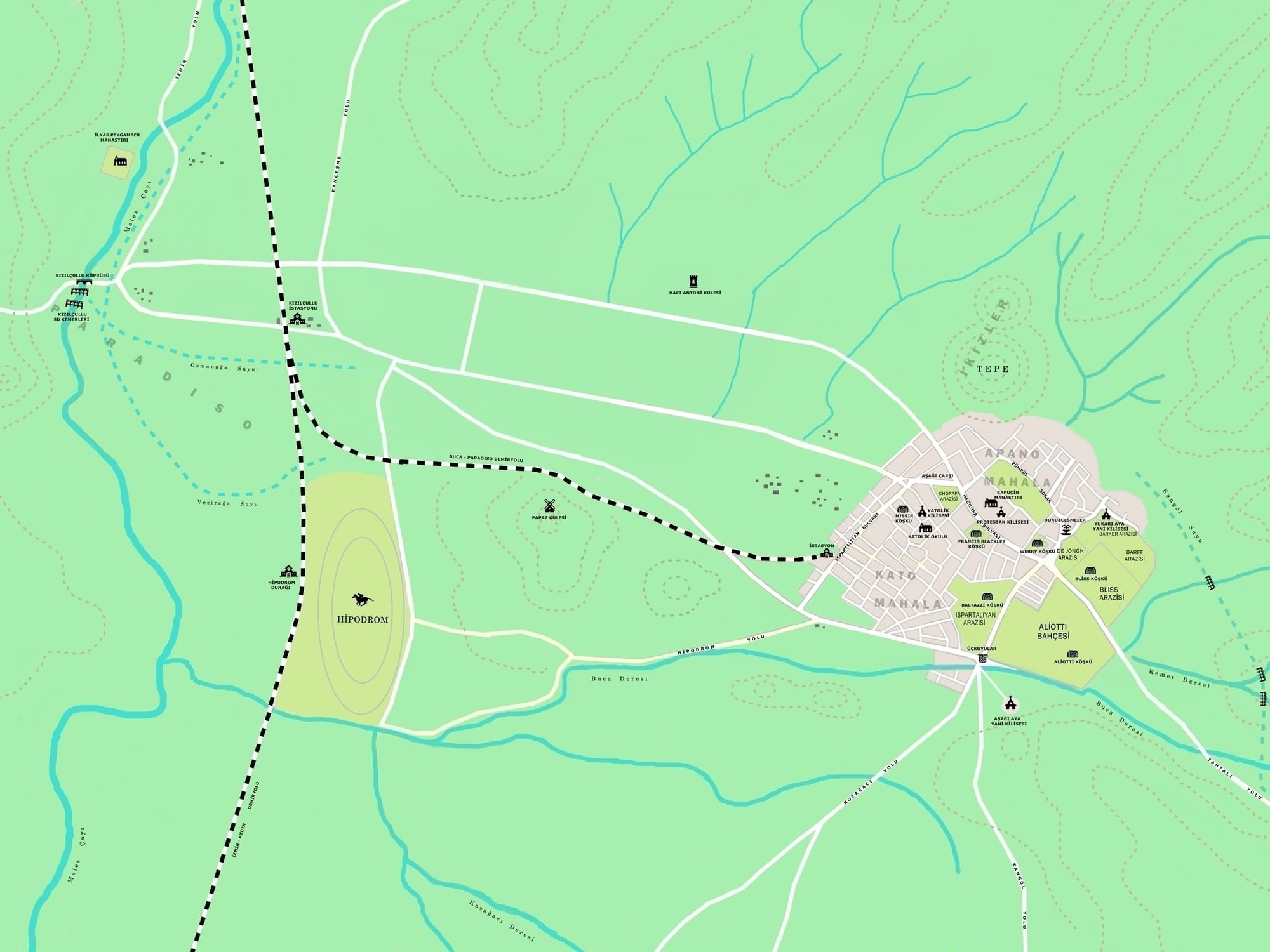 1850 - 1900 arasında Buca Ovası - Tam ekran için tıklayınız.With the arrival of the railway to Buca in the second half of the 19th century, migration to Buca accelerated. Especially the British population has increased significantly in Buca and has become the majority among European families. Of course, Aydın-İzmir Railway, a British company, had a huge share in this. During this period, the Dutch population decreased for an unknown reason, while the Italian and French populations increased, although much less than the British. Armenian, Jewish and Muslim populations were added to these communities for the first time, and Buca became richer in terms of population diversity during this period. Despite all these migrations, Greeks continued to constitute the majority of Buca's population.
1850 - 1900 arasında Buca Ovası - Tam ekran için tıklayınız.With the arrival of the railway to Buca in the second half of the 19th century, migration to Buca accelerated. Especially the British population has increased significantly in Buca and has become the majority among European families. Of course, Aydın-İzmir Railway, a British company, had a huge share in this. During this period, the Dutch population decreased for an unknown reason, while the Italian and French populations increased, although much less than the British. Armenian, Jewish and Muslim populations were added to these communities for the first time, and Buca became richer in terms of population diversity during this period. Despite all these migrations, Greeks continued to constitute the majority of Buca's population.
Buca's neighborhoods continue to expand. The construction around the station is increasing and the lower neighborhood is expanding towards the south. A Turkish neighborhood is being established in the upper neighborhood towards Tıngırtepe. In addition, there is also a Circassian neighborhood in the upper neighborhood of Buca.
The establishment of a hippodrome for horse racing in Paradiso coincided with this period. As a result, the Paradiso region gained value. The construction of houses with large gardens and the establishment of an orderly settlement in Paradiso also coincides with this period. Nevertheless, the population of Paradiso remained too small to be called a village during this period.
- Between 1900 and 1922 -
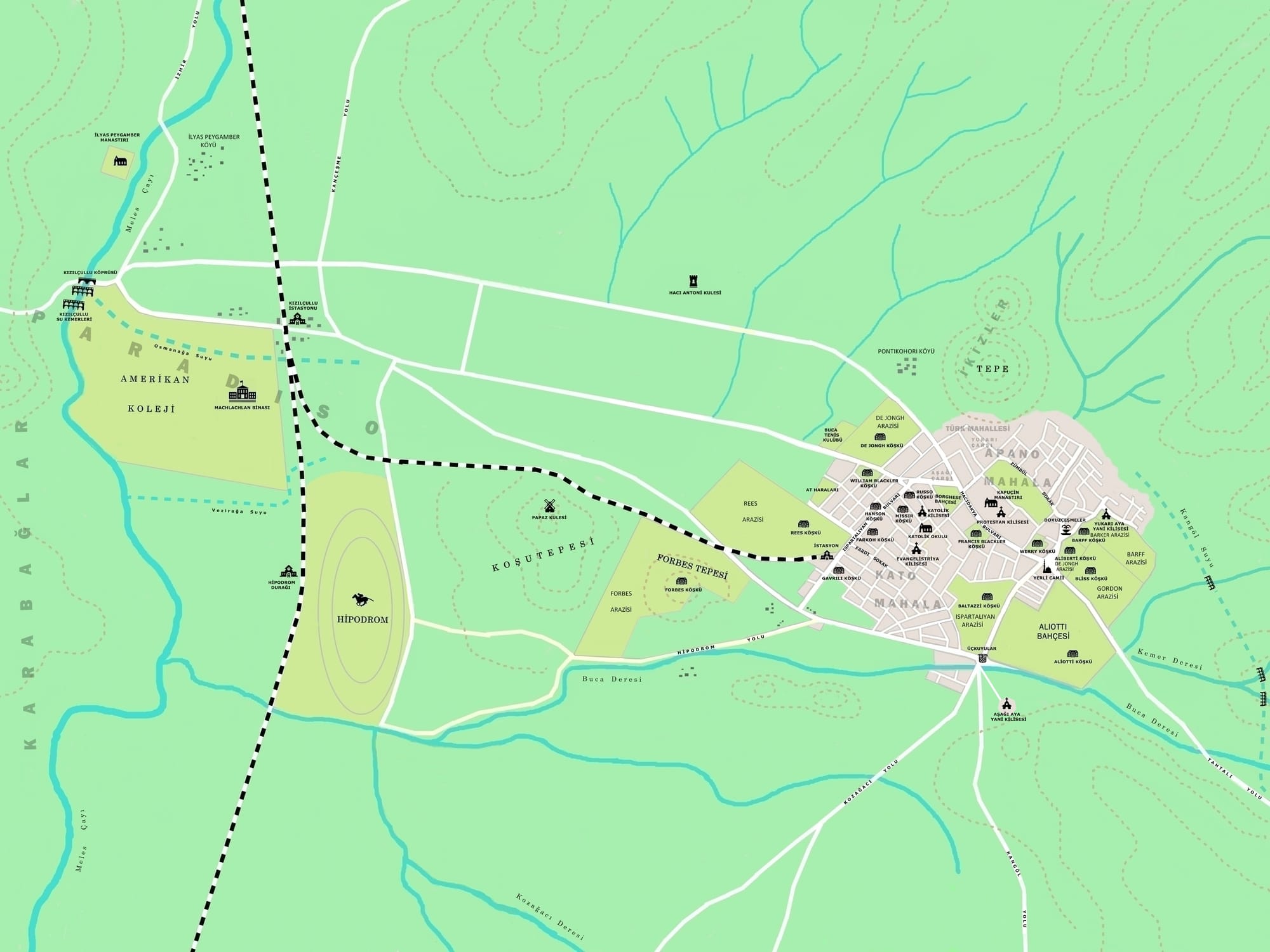 1900 - 1922 arasında Buca Ovası - Tam ekran için tıklayınız.It can be said that as the Ottoman Empire lost a large amount of land, the migration of the Greek population to Buca continued to increase. Greece's continued expansion gives confidence to the Greeks in the region, and the Greeks are making many future initiatives in Buca, as in Izmir and its surroundings. Social activity areas such as theaters and cafes are being opened in Buca. A new orthodox church was opened in 1903 in order to meet the needs of the increasing population. European families continue to purchase land from Buca. Famous mansions such as Rees, De Jongh and Forbes were built on large lands during this period. There is a village founded by Greeks on the outskirts of Tıngırtepe, just north of Buca, and its name is Pontikohori village. Its name has been carried on until today and today it is known as Sıçanköy.
1900 - 1922 arasında Buca Ovası - Tam ekran için tıklayınız.It can be said that as the Ottoman Empire lost a large amount of land, the migration of the Greek population to Buca continued to increase. Greece's continued expansion gives confidence to the Greeks in the region, and the Greeks are making many future initiatives in Buca, as in Izmir and its surroundings. Social activity areas such as theaters and cafes are being opened in Buca. A new orthodox church was opened in 1903 in order to meet the needs of the increasing population. European families continue to purchase land from Buca. Famous mansions such as Rees, De Jongh and Forbes were built on large lands during this period. There is a village founded by Greeks on the outskirts of Tıngırtepe, just north of Buca, and its name is Pontikohori village. Its name has been carried on until today and today it is known as Sıçanköy.
The village of Paradiso has become a regular settlement. The establishment of the American College during this period changed the face of Paradiso. In addition, the village of Prophet İlyas, with a Greek population, was established nearby. Many places, especially Kozağaç and Çamlık, have become recreation areas. This period can be said to be Buca's most vibrant period, and Buca would not regain this vitality until the 1970s.
- Between 1922 and 1950 -
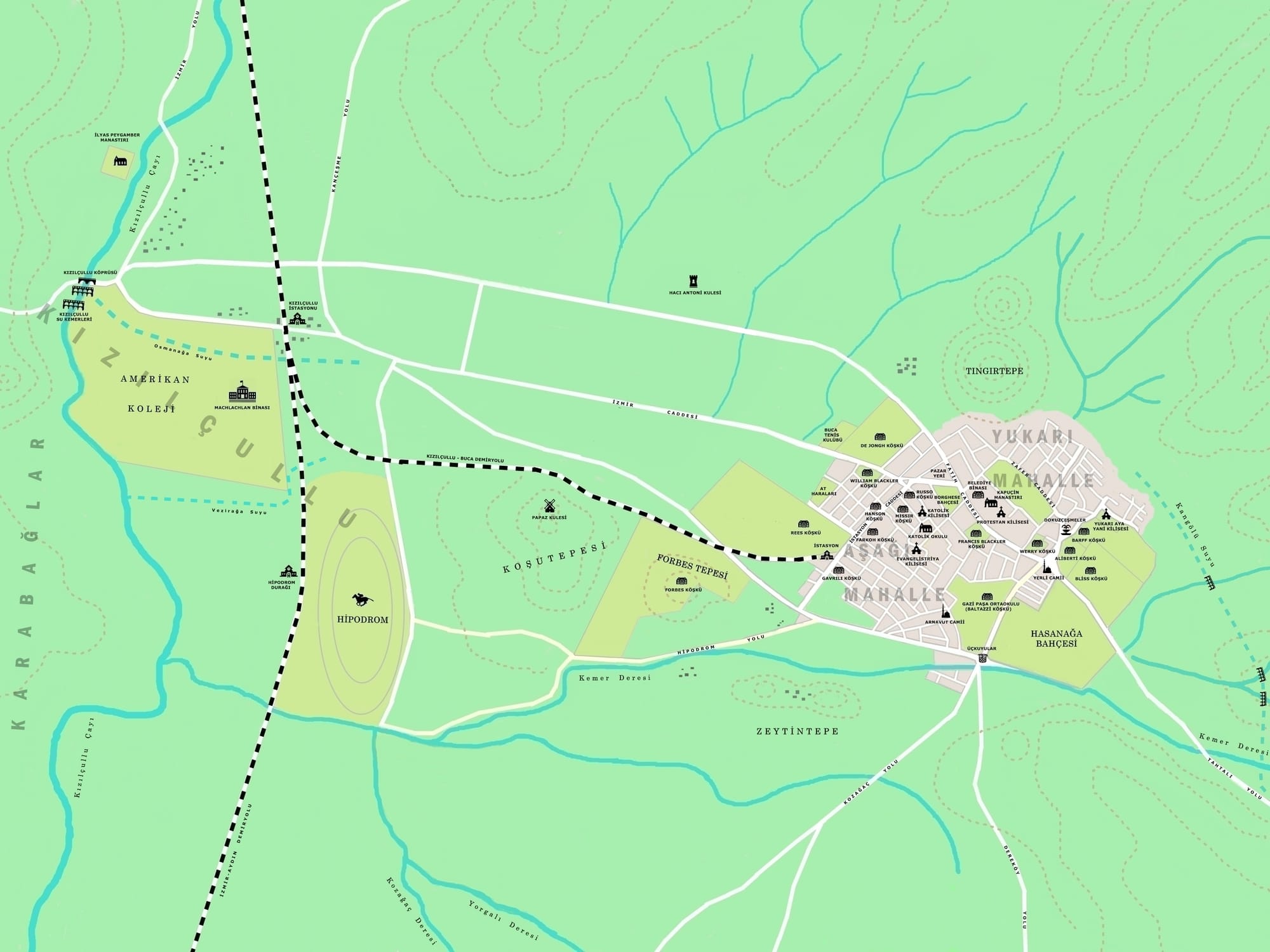 1922 - 1950 arasında Buca Ovası - Tam ekran için tıklayınız.After the Greeks completely left Buca after the Turkish War of Independence, the economic order, especially trade, completely changed in Buca. After the departure of the Greeks, who had strong ties with European families and had a significant influence in commercial life, the European families who remained in Buca had great difficulty in finding qualified human resources to replace them. In addition, Muslim immigrants from the Balkan geography did not know the agricultural methods of the region like the Greeks of Buca. Therefore, the economy of the region has undergone major changes in terms of both trade and agriculture.
1922 - 1950 arasında Buca Ovası - Tam ekran için tıklayınız.After the Greeks completely left Buca after the Turkish War of Independence, the economic order, especially trade, completely changed in Buca. After the departure of the Greeks, who had strong ties with European families and had a significant influence in commercial life, the European families who remained in Buca had great difficulty in finding qualified human resources to replace them. In addition, Muslim immigrants from the Balkan geography did not know the agricultural methods of the region like the Greeks of Buca. Therefore, the economy of the region has undergone major changes in terms of both trade and agriculture.
There would not be a major change in Buca until the 1950s. The lower and upper neighborhoods of the Greeks continued to be used in the same way by Muslim immigrants who came to Buca. The train line continues to be of vital importance for Buca and İstasyon Street is still the most important street in Buca. Formerly large lands belonging to Europeans either passed to the state or were used by other families, leaving the hands of their former owners.
Kızılçullu (Greek: Paradiso) continued to be a small village without undergoing any major changes, like Buca. It is seen that large and small dwellings were built opposite the Prophet Elijah Monastery.
- Between 1950 and 1960 -
 1950 - 1960 arasında Buca Ovası - Tam ekran için tıklayınız.Although the upper and lower neighborhoods of Buca remain largely the same, the upper neighborhood is expanding towards Tıngırtepe and to the north. The lower neighborhood expands below the station and towards the west. Zeytintepe neighborhood was established on a slightly elevated hill in the south of Buca. Additionally, with the transfer of the old American College in Kızılçullu to NATO, a new era will begin in Kızılçullu and Kızılçullu will begin to grow rapidly within a period of ten years.
1950 - 1960 arasında Buca Ovası - Tam ekran için tıklayınız.Although the upper and lower neighborhoods of Buca remain largely the same, the upper neighborhood is expanding towards Tıngırtepe and to the north. The lower neighborhood expands below the station and towards the west. Zeytintepe neighborhood was established on a slightly elevated hill in the south of Buca. Additionally, with the transfer of the old American College in Kızılçullu to NATO, a new era will begin in Kızılçullu and Kızılçullu will begin to grow rapidly within a period of ten years.
During these years, immigration from Albania, Yugoslavia and Bulgaria continued to come to Buca. With these migrations, the Muslim population began to constitute the majority of Buca and the non-Muslim population decreased rapidly.
During this period, Workers' Houses began to be built between Buca and Kızılçullu in 1953, and a prison began to be built in 1954.
This article was created by atalarimizintopraklari.com. All rights reserved. All or part of this article cannot be used in books, magazines or newspapers without citing the source.
- Sources -
sepik.net/o-boutzas-tis-smirnis/
levantineheritage.com/note132.htm
Candlesticks, Vol I, no. 6 - Boudja Past and Present, Hilda Voltera Barff, 1951-52 Winter
Buca, Nikos Kararas, 1962